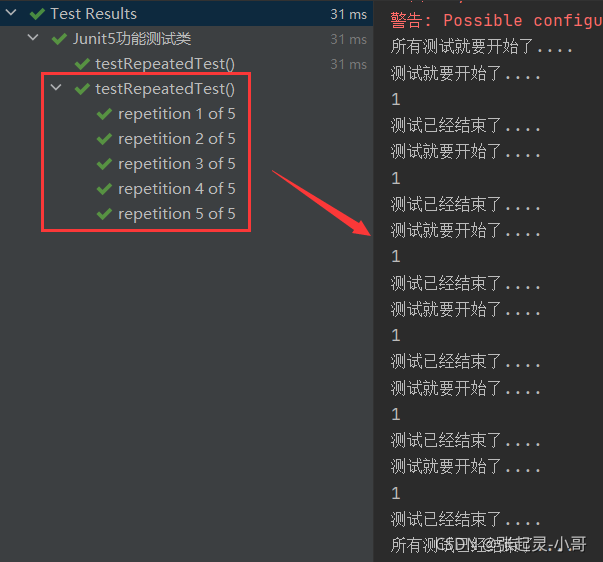文章目录:
2.1 @DisplayName、@Disabled、@BeforeEach、@AfterEach、@BeforeAll、@AfterAll
1.JUnit5的变化
Spring Boot 2.2.0 版本开始引入 JUnit 5 作为单元测试默认库
作为最新版本的JUnit框架,JUnit5与之前版本的Junit框架有很大的不同。由三个不同子项目的几个不同模块组成。
JUnit 5 = JUnit Platform + JUnit Jupiter + JUnit Vintage
JUnit Platform: Junit Platform是在JVM上启动测试框架的基础,不仅支持Junit自制的测试引擎,其他测试引擎也都可以接入。
JUnit Jupiter: JUnit Jupiter提供了JUnit5的新的编程模型,是JUnit5新特性的核心。内部包含了一个测试引擎,用于在Junit Platform上运行。
JUnit Vintage: 由于JUint已经发展多年,为了照顾老的项目,JUnit Vintage提供了兼容JUnit4.x,Junit3.x的测试引擎。
注意:SpringBoot 2.4 以上版本移除了默认对 Vintage 的依赖。如果需要兼容junit4需要自行引入(不能使用junit4的功能 @Test)
JUnit 5’s Vintage Engine Removed from spring-boot-starter-test,如果需要继续兼容junit4需要自行引入vintage
<dependency> <groupId>org.junit.vintage</groupId> <artifactId>junit-vintage-engine</artifactId> <scope>test</scope> <exclusions> <exclusion> <groupId>org.hamcrest</groupId> <artifactId>hamcrest-core</artifactId> </exclusion> </exclusions> </dependency>
如果只使用JUnit5的特性,那么就需要添加下面的依赖。
<dependency> <groupId>org.springframework.boot</groupId> <artifactId>spring-boot-starter-test</artifactId> <scope>test</scope> </dependency>
import org.junit.jupiter.api.Test; import org.springframework.boot.test.context.SpringBootTest; @SpringBootTest class SpringbootActuatorApplicationTests { @Test void contextLoads() { } }
2.JUnit5常用注解及测试
JUnit5的注解与JUnit4的注解有所变化
· @Test :表示方法是测试方法。但是与JUnit4的@Test不同,他的职责非常单一不能声明任何属性,拓展的测试将会由Jupiter提供额外测试
· @ParameterizedTest :表示方法是参数化测试,下方会有详细介绍
· @RepeatedTest :表示方法可重复执行,下方会有详细介绍
· @DisplayName :为测试类或者测试方法设置展示名称
· @BeforeEach :表示在每个单元测试之前执行
· @AfterEach :表示在每个单元测试之后执行
· @BeforeAll :表示在所有单元测试之前执行
· @AfterAll :表示在所有单元测试之后执行
· @Tag :表示单元测试类别,类似于JUnit4中的@Categories
· @Disabled :表示测试类或测试方法不执行,类似于JUnit4中的@Ignore
· @Timeout :表示测试方法运行如果超过了指定时间将会返回错误
· @ExtendWith :为测试类或测试方法提供扩展类引用
2.1 @DisplayName、@Disabled、@BeforeEach、@AfterEach、@BeforeAll、@AfterAll
package com.szh.boot; import org.junit.jupiter.api.*; import java.time.Duration; import java.util.concurrent.TimeUnit; import static org.junit.jupiter.api.Assertions.*; /** * */ //@SpringBootTest @DisplayName("Junit5功能测试类") public class TestJunit { //----------------------------常用注解---------------------------- @DisplayName("测试DisplayName注解---方法1") @Test public void testDisplayName1() { System.out.println(123); } @Disabled @DisplayName("测试DisplayName注解---方法2") @Test public void testDisplayName2() { System.out.println(456); } @BeforeEach public void testBeforeEach() { System.out.println("测试就要开始了...."); } @AfterEach public void testAfterEach() { System.out.println("测试已经结束了...."); } @BeforeAll public static void testBeforeAll() { System.out.println("所有测试就要开始了...."); } @AfterAll public static void testAfterAll() { System.out.println("所有测试已经结束了...."); } }
我们再把 testDisplayName2 方法上的@Disabled注解打开。可以看到,这个测试方法已经被禁用了。
2.2 @Timeout
package com.szh.boot; import org.junit.jupiter.api.*; import java.time.Duration; import java.util.concurrent.TimeUnit; import static org.junit.jupiter.api.Assertions.*; /** * */ //@SpringBootTest @DisplayName("Junit5功能测试类") public class TestJunit { @BeforeEach public void testBeforeEach() { System.out.println("测试就要开始了...."); } @AfterEach public void testAfterEach() { System.out.println("测试已经结束了...."); } @BeforeAll public static void testBeforeAll() { System.out.println("所有测试就要开始了...."); } @AfterAll public static void testAfterAll() { System.out.println("所有测试已经结束了...."); } @DisplayName("测试Timeout注解") @Timeout(value = 5, unit = TimeUnit.MILLISECONDS) @Test public void testTimeout() throws InterruptedException { Thread.sleep(1000); } }
2.3 @RepeatedTest
package com.szh.boot; import org.junit.jupiter.api.*; import java.time.Duration; import java.util.concurrent.TimeUnit; import static org.junit.jupiter.api.Assertions.*; /** * */ //@SpringBootTest @DisplayName("Junit5功能测试类") public class TestJunit { @BeforeEach public void testBeforeEach() { System.out.println("测试就要开始了...."); } @AfterEach public void testAfterEach() { System.out.println("测试已经结束了...."); } @BeforeAll public static void testBeforeAll() { System.out.println("所有测试就要开始了...."); } @AfterAll public static void testAfterAll() { System.out.println("所有测试已经结束了...."); } @RepeatedTest(5) @Test public void testRepeatedTest() { System.out.println(1); } }
3.断言
断言(assertions)是测试方法中的核心部分,用来对测试需要满足的条件进行验证。这些断言方法都是org.junit.jupiter.api.Assertions 的静态方法。JUnit 5 内置的断言可以分成如下几个类别:
检查业务逻辑返回的数据是否合理。
所有的测试运行结束以后,会有一个详细的测试报告;
3.1 简单断言
用来对单个值进行简单的验证。如:
方法 |
说明 |
assertEquals |
判断两个对象或两个原始类型是否相等 |
assertNotEquals |
判断两个对象或两个原始类型是否不相等 |
assertSame |
判断两个对象引用是否指向同一个对象 |
assertNotSame |
判断两个对象引用是否指向不同的对象 |
assertTrue |
判断给定的布尔值是否为 true |
assertFalse |
判断给定的布尔值是否为 false |
assertNull |
判断给定的对象引用是否为 null |
assertNotNull |
判断给定的对象引用是否不为 null |
package com.szh.boot; import org.junit.jupiter.api.*; import java.time.Duration; import java.util.concurrent.TimeUnit; import static org.junit.jupiter.api.Assertions.*; /** * */ //@SpringBootTest @DisplayName("Junit5功能测试类") public class TestJunit { @BeforeEach public void testBeforeEach() { System.out.println("测试就要开始了...."); } @AfterEach public void testAfterEach() { System.out.println("测试已经结束了...."); } @BeforeAll public static void testBeforeAll() { System.out.println("所有测试就要开始了...."); } @AfterAll public static void testAfterAll() { System.out.println("所有测试已经结束了...."); } //----------------------------断言---------------------------- /** * 如果前面的断言失败,则后面的代码不会再执行 */ @DisplayName("测试简单断言") @Test public void testSimpleAssertions() { int result = cal(1,2); assertEquals(5,result,"业务逻辑计算结果出错...."); Object obj1 = new Object(); Object obj2 = new Object(); assertSame(obj1,obj2); } public int cal(int x, int y) { return x + y; } }
assertEquals方法判断出运算结果不同,也即此时第一个断言失败了,那么后面的assertSame不会再执行。
当我们修改assertEquals方法使其断言成功,那么后续的assertSame将会继续执行。
此时看到的就是assertSame方法打印的异常信息(两个对象不相等)。
assertEquals(3,result,"业务逻辑计算结果出错....");
3.2 数组断言
通过assertArrayEquals 方法来判断两个对象或原始类型的数组是否相等。
package com.szh.boot; import org.junit.jupiter.api.*; import java.time.Duration; import java.util.concurrent.TimeUnit; import static org.junit.jupiter.api.Assertions.*; /** * */ //@SpringBootTest @DisplayName("Junit5功能测试类") public class TestJunit { @BeforeEach public void testBeforeEach() { System.out.println("测试就要开始了...."); } @AfterEach public void testAfterEach() { System.out.println("测试已经结束了...."); } @BeforeAll public static void testBeforeAll() { System.out.println("所有测试就要开始了...."); } @AfterAll public static void testAfterAll() { System.out.println("所有测试已经结束了...."); } //----------------------------断言---------------------------- @DisplayName("测试数组断言1") @Test public void testArrayAssertions1() { assertArrayEquals(new int[]{1,2}, new int[]{1,2}); } @DisplayName("测试数组断言2") @Test public void testArrayAssertions2() { assertArrayEquals(new int[]{3,4}, new int[]{1,2}, "数组内容不相等...."); } }
3.3 组合断言
assertAll 方法接受多个org.junit.jupiter.api.Executable 函数式接口的实例作为要验证的断言,可以通过 lambda 表达式很容易的提供这些断言。
package com.szh.boot; import org.junit.jupiter.api.*; import java.time.Duration; import java.util.concurrent.TimeUnit; import static org.junit.jupiter.api.Assertions.*; /** * */ //@SpringBootTest @DisplayName("Junit5功能测试类") public class TestJunit { @BeforeEach public void testBeforeEach() { System.out.println("测试就要开始了...."); } @AfterEach public void testAfterEach() { System.out.println("测试已经结束了...."); } @BeforeAll public static void testBeforeAll() { System.out.println("所有测试就要开始了...."); } @AfterAll public static void testAfterAll() { System.out.println("所有测试已经结束了...."); } //----------------------------断言---------------------------- @DisplayName(("测试组合断言")) @Test public void testAllAssertions() { assertAll("testAll", () -> assertTrue(true && true), () -> assertEquals(1,2)); //当以上两个断言全部成功时,才会打印下面的内容 System.out.println("success!!!"); } }
组合断言中,当所有断言都成功时,代码才会顺利向下执行。assertTrue虽然执行成功了,但是assertEquals失败了,所有下面的sout不会执行。
3.4 异常断言
在JUnit4时期,想要测试方法的异常情况时,需要用@Rule注解的ExpectedException变量还是比较麻烦的。而JUnit5提供了一种新的断言方式Assertions.assertThrows(),配合函数式编程就可以进行使用。
package com.szh.boot; import org.junit.jupiter.api.*; import java.time.Duration; import java.util.concurrent.TimeUnit; import static org.junit.jupiter.api.Assertions.*; /** * */ //@SpringBootTest @DisplayName("Junit5功能测试类") public class TestJunit { @BeforeEach public void testBeforeEach() { System.out.println("测试就要开始了...."); } @AfterEach public void testAfterEach() { System.out.println("测试已经结束了...."); } @BeforeAll public static void testBeforeAll() { System.out.println("所有测试就要开始了...."); } @AfterAll public static void testAfterAll() { System.out.println("所有测试已经结束了...."); } //----------------------------断言---------------------------- @DisplayName("测试异常断言") @Test public void testExceptionAssertions() { assertThrows(ArithmeticException.class,() -> { int i = 10 / 2; //此时断言会执行 //int j = 10 / 0; //此时断言不会执行 },"业务逻辑居然正常运行???"); } }
如果代码执行 int i = 10 / 2 运行正确,不会出现 ArithmeticException 异常,所以此时assertThrows断言会执行。反之则不会执行。
3.5 超时断言
Junit5还提供了Assertions.assertTimeout()为测试方法设置了超时时间。
package com.szh.boot; import org.junit.jupiter.api.*; import java.time.Duration; import java.util.concurrent.TimeUnit; import static org.junit.jupiter.api.Assertions.*; /** * */ //@SpringBootTest @DisplayName("Junit5功能测试类") public class TestJunit { @BeforeEach public void testBeforeEach() { System.out.println("测试就要开始了...."); } @AfterEach public void testAfterEach() { System.out.println("测试已经结束了...."); } @BeforeAll public static void testBeforeAll() { System.out.println("所有测试就要开始了...."); } @AfterAll public static void testAfterAll() { System.out.println("所有测试已经结束了...."); } @DisplayName("测试超时断言") @Test public void testTimeoutAssertions() { assertTimeout(Duration.ofMillis(1000), () -> Thread.sleep(2000)); } }
3.6 快速失败
通过 fail 方法直接使得测试失败。
package com.szh.boot; import org.junit.jupiter.api.*; import java.time.Duration; import java.util.concurrent.TimeUnit; import static org.junit.jupiter.api.Assertions.*; /** * */ //@SpringBootTest @DisplayName("Junit5功能测试类") public class TestJunit { @BeforeEach public void testBeforeEach() { System.out.println("测试就要开始了...."); } @AfterEach public void testAfterEach() { System.out.println("测试已经结束了...."); } @BeforeAll public static void testBeforeAll() { System.out.println("所有测试就要开始了...."); } @AfterAll public static void testAfterAll() { System.out.println("所有测试已经结束了...."); } @DisplayName("快速失败") @Test public void testFailAssertions() { System.out.println(1); System.out.println(2); fail("直接走人...."); System.out.println(3); System.out.println(4); } }
4.前置条件
JUnit 5 中的前置条件(assumptions【假设】)类似于断言,不同之处在于不满足的断言会使得测试方法失败,而不满足的前置条件只会使得测试方法的执行终止。前置条件可以看成是测试方法执行的前提,当该前提不满足时,就没有继续执行的必要。
package com.szh.boot; import org.junit.jupiter.api.*; import java.time.Duration; import java.util.concurrent.TimeUnit; import static org.junit.jupiter.api.Assertions.*; /** * */ //@SpringBootTest @DisplayName("Junit5功能测试类") public class TestJunit { @BeforeEach public void testBeforeEach() { System.out.println("测试就要开始了...."); } @AfterEach public void testAfterEach() { System.out.println("测试已经结束了...."); } @BeforeAll public static void testBeforeAll() { System.out.println("所有测试就要开始了...."); } @AfterAll public static void testAfterAll() { System.out.println("所有测试已经结束了...."); } //----------------------------前置条件---------------------------- @DisplayName("测试前置条件") @Test public void testAssumptions() { Assumptions.assumeTrue(true, "结果不是true...."); System.out.println(111); } }
将Assumptions.assumeTrue(false, "结果不是true....");中的 true 改为 false,此时因为 true != false,所以不满足该前置条件,则直接导致测试方法被终止执行。
5.嵌套测试
JUnit 5 可以通过 Java 中的内部类和@Nested 注解实现嵌套测试,从而可以更好的把相关的测试方法组织在一起。在内部类中可以使用@BeforeEach 和@AfterEach 注解,而且嵌套的层次没有限制。
package com.szh.boot; import org.junit.jupiter.api.BeforeEach; import org.junit.jupiter.api.DisplayName; import org.junit.jupiter.api.Nested; import org.junit.jupiter.api.Test; import java.util.EmptyStackException; import java.util.Stack; import static org.junit.jupiter.api.Assertions.*; /** * 嵌套测试中,外层的@Test不能驱动内层的@Before(After)Each/All之类的方法提前/之后运行 * 内层的@Test可以驱动外层的@Before(After)Each/All之类的方法提前/之后运行 */ @DisplayName("A stack") public class TestingAStackDemo { Stack<Object> stack; @Test @DisplayName("is instantiated with new Stack()") void isInstantiatedWithNew() { new Stack<>(); } @Nested @DisplayName("when new") class WhenNew { @BeforeEach void createNewStack() { stack = new Stack<>(); } @Test @DisplayName("is empty") void isEmpty() { assertTrue(stack.isEmpty()); } @Test @DisplayName("throws EmptyStackException when popped") void throwsExceptionWhenPopped() { assertThrows(EmptyStackException.class, stack::pop); } @Test @DisplayName("throws EmptyStackException when peeked") void throwsExceptionWhenPeeked() { assertThrows(EmptyStackException.class, stack::peek); } @Nested @DisplayName("after pushing an element") class AfterPushing { String anElement = "an element"; @BeforeEach void pushAnElement() { stack.push(anElement); } @Test @DisplayName("it is no longer empty") void isNotEmpty() { assertFalse(stack.isEmpty()); } @Test @DisplayName("returns the element when popped and is empty") void returnElementWhenPopped() { assertEquals(anElement, stack.pop()); assertTrue(stack.isEmpty()); } @Test @DisplayName("returns the element when peeked but remains not empty") void returnElementWhenPeeked() { assertEquals(anElement, stack.peek()); assertFalse(stack.isEmpty()); } } } }
6.参数化测试
参数化测试是JUnit5很重要的一个新特性,它使得用不同的参数多次运行测试成为了可能,也为我们的单元测试带来许多便利。
利用@ValueSource等注解,指定入参,我们将可以使用不同的参数进行多次单元测试,而不需要每新增一个参数就新增一个单元测试,省去了很多冗余代码。
@ValueSource: 为参数化测试指定入参来源,支持八大基础类以及String类型,Class类型
@NullSource: 表示为参数化测试提供一个null的入参
@EnumSource: 表示为参数化测试提供一个枚举入参
@CsvFileSource:表示读取指定CSV文件内容作为参数化测试入参
@MethodSource:表示读取指定方法的返回值作为参数化测试入参(注意方法返回需要是一个流)
7.JUnit4 → Junit5
https://junit.org/junit5/docs/current/user-guide/#migrating-from-junit4
在进行迁移的时候需要注意如下的变化:
· 注解在org.junit.jupiter.api 包中,断言在org.junit.jupiter.api.Assertions 类中,前置条件在org.junit.jupiter.api.Assumptions 类中。
· 把@Before 和@After 替换成@BeforeEach 和@AfterEach。
· 把@BeforeClass 和@AfterClass 替换成@BeforeAll 和@AfterAll。
· 把@Ignore 替换成@Disabled。
· 把@Category 替换成@Tag。
· 把@RunWith、@Rule 和@ClassRule 替换成@ExtendWith。















